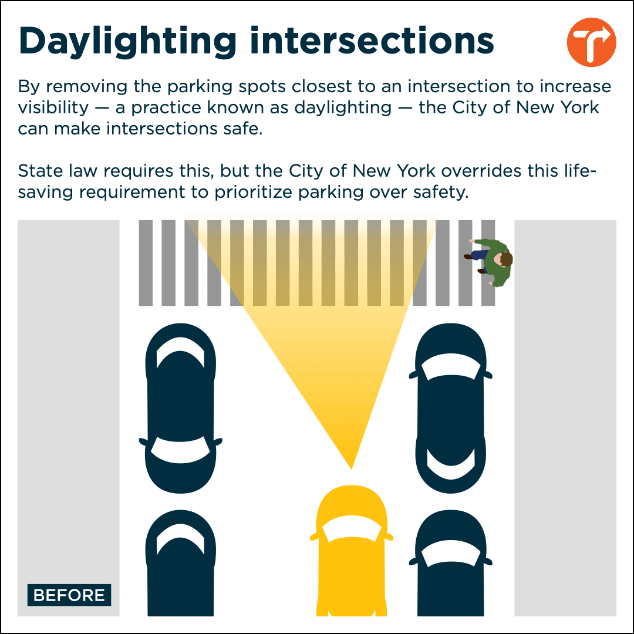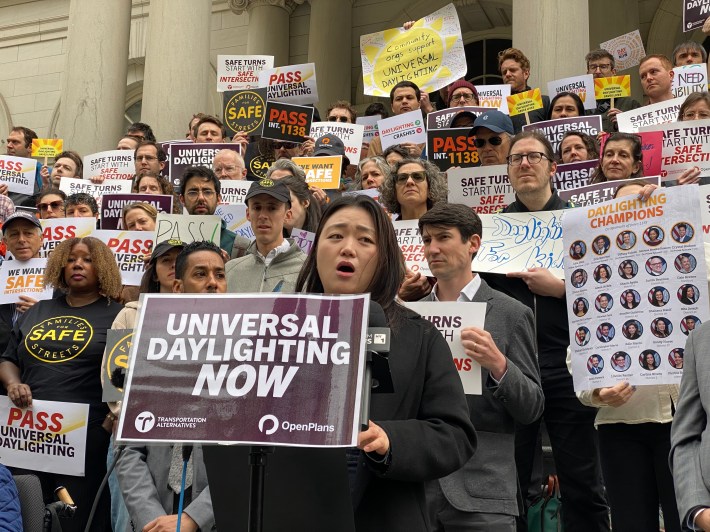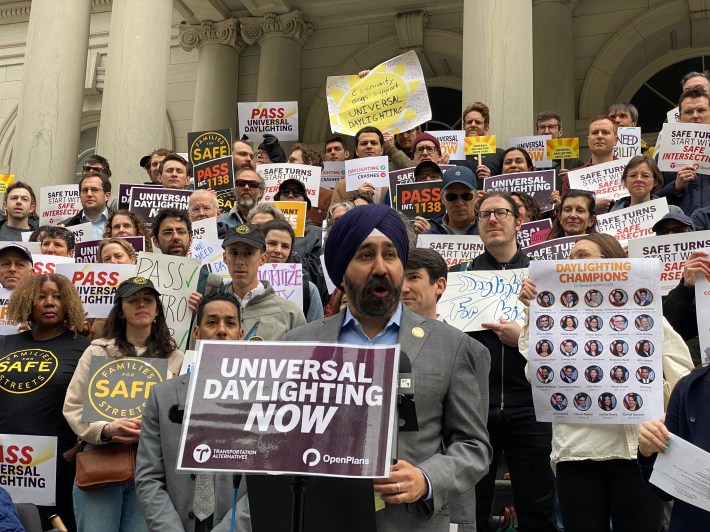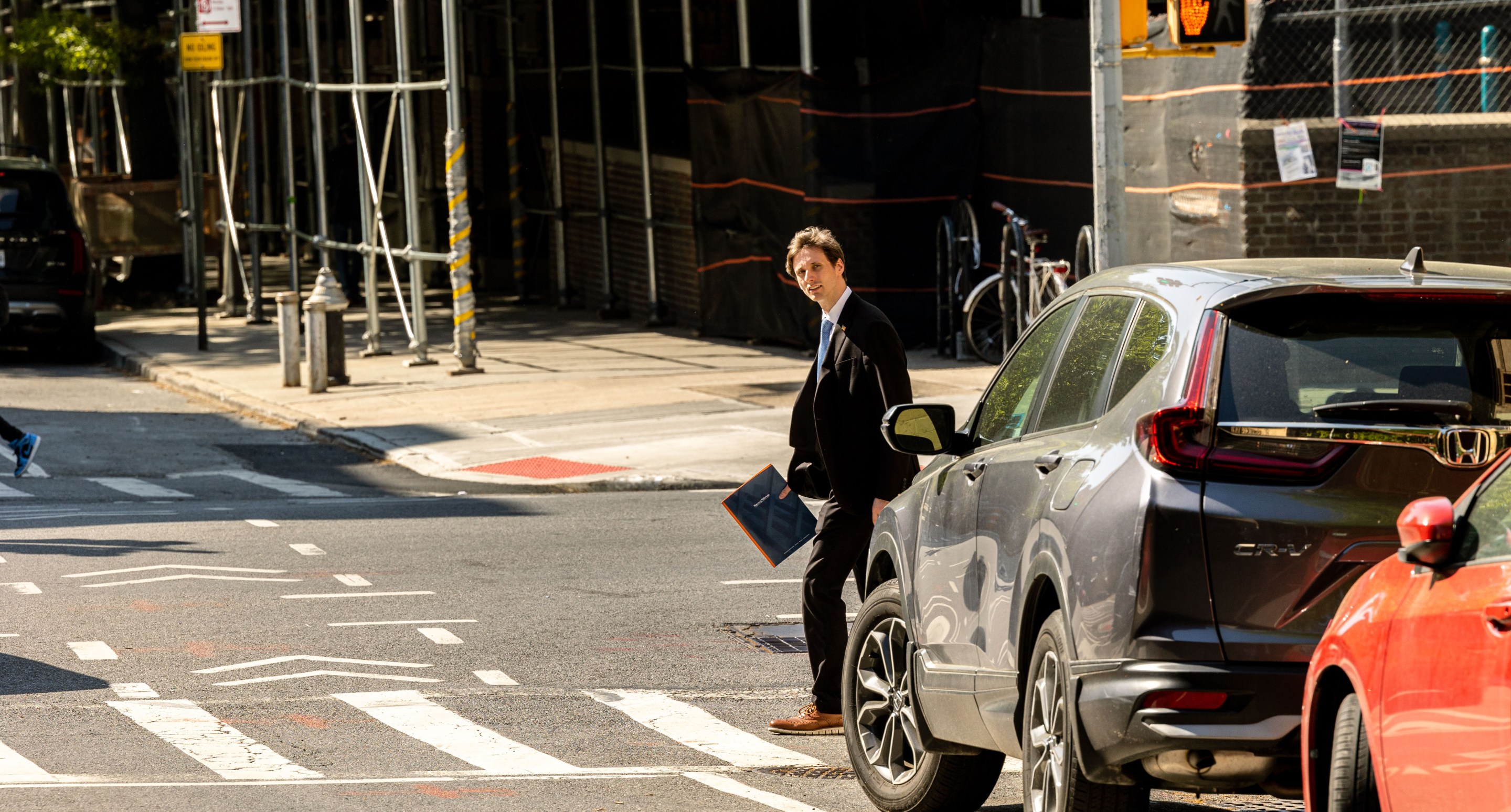The Adams administration trotted out frightening injury scenarios and moonshot-type price tags at a packed Council hearing on Monday where supporters championed a proposal to ban parking at all corners for better visibility and traffic safety, a redesign also known as daylighting.
Some 15,000 more people would be injured in crashes if the city implements no-parking zones within 20 feet of crosswalks without adding hard infrastructure to block illegal parkers, said a senior Department of Transportation official, citing a recent agency daylighting study that advocates have criticized for resting on shaky stats.

"While daylighting is a useful tool when used properly, indiscriminate daylighting could actually have negative effects on safety," Eric Beaton, the deputy commissioner testified. "The results of our study were surprising, even to us, but speak to the importance of doing good analysis and then being willing to update our beliefs based on what we find."
The study found a 30-percent higher injury rate at corners with a fire hydrant or bus stop than those with parked cars, covering around 7,500 out of the city's roughly 40,000 intersections, which would yield the 15,000-increase if DOT implemented the no-parking regulations everywhere.
DOT did find drops in crashes for intersections that blocked cars with hard infrastructure, such as bike racks or boulders, according to its January report. But scaling up the latter treatment to all intersections would cost $3 billion, according to Beaton.
The agency's leaders say they'd rather add daylighting at specific locations, instead of having to implement the policy everywhere.
Clearing corners of obstructive cars has been standard practice across more than 40 states and as far back as the 1920s, including in New York State, but the Big Apple exempts itself in favor of more parking.
Cities that have moved to enforce the policy have logged safety benefits near and far without spending big, and New York City advocates have mobilized a grass-roots effort over the past year culminating in a promising piece of Council legislation.
Queens Council Member Julie Won's daylighting bill has 25 sponsors as of Monday, and would require the city to ban parking within 20 feet of all intersections.

The proposal would also make the agency add hard infrastructure to 1,000 of those corners each year.
A staggering 55 percent of pedestrian deaths and 79 percent of pedestrian traffic injuries happen at intersections, according to DOT, and Won grilled officials for working overtime to disprove a simple and effective way to reduce those numbers.
"DOT clearly began with a conclusion and then used flawed data to support that conclusion," Won said at the Council hearing. "Policy must be backed by good data, but the methodology of DOT’s report is deeply flawed."
Critics have pointed out that the study lacks key details, like whether a crash actually happened at a corner with daylighting or across the street, and if the zones with hydrants and bus stops were free of illegal parking that plagues the city. The city's report admits that flaw.
Beaton defended the agency's deep dive when Streetsblog confronted him with the agency's own admission that researchers did not know where at an intersection crashes occurred or whether the corner was in fact daylighted or whether a car was illegally parked at the hydrant or bus stop.
"All we can say is that those intersections had more injuries that those that didn’t. It doesn’t say, this caused that necessarily, but when you’re talking about… 8,000 locations, it is indicative that there may be something going on there," the senior DOT official told Streetsblog.

The cost of hardened daylighting infrastructure comes at about $10,000 per location, which includes labor and regular maintenance, Beaton estimated. But the cost of daylighting all the intersections swells to $3 billion because the agency would need more staff and locations to store the objects that create the hardened, car-free space.
North Brooklyn Council Member Lincoln Restler slammed DOT for claiming it has a targeted approach to daylighting already, because he surveyed his constituents for the worst crossings and created a list of 107 recommendations; the agency ended up only fixing two: Monitor Street and Driggs Avenue, and Manhattan and Norman avenues.
"I’m at my wit’s end because I keep bringing these same corners up that are notoriously dangerous … and two out of 107 get fixed in the better part of a year," said Restler. "You basically did nothing."
The proposed policy would also run up against parking-first local lawmakers, and Beaton forecast that 300,000 parking spaces citywide would have to be repurposed for intersection daylighting, about one-in-10 of the roughly three million spaces the city currently gives away to drivers largely for free.
"Knowing that the sponsors of this bill are willing to repurpose so much vehicle parking — as much as 300,000 spaces citywide, or an average of 6,500 parking spaces per Council district — we would like to work with you on how we can best use this space to maximize street safety," said Beaton.
For comparison, the expansion of outdoor dining into the roadway during the pandemic reused curb space of 8,550 motor vehicles, a pittance — yet the Council truncated the program.
One opponent of the daylighting bill summed up the anti-safety argument perfectly, saying he put a greater value on his constituents' ability to store their private cars.
"We understand there’s a need for safety, but when folks have to double-park and block the street late at night, that shouldn’t be," said Council Member Chris Banks (D–East New York). "If it’s definitely going to put a strain on the already scarcity in parking, that’s obviously something I’m not a supporter of."
In Banks's district, 54 percent of households do not have access to a car, and the area suffers from the sixth-highest traffic death rate in the city, according to data mapped by the Massachusetts Institute of Technology and Transportation Alternatives.
Meanwhile, as scores of pedestrians are killed every year in New York City, other cities have been moving full steam ahead with daylighting. For instance, Hoboken, New Jersey, which has been all-in on daylight, has not logged a traffic death in eight years.
"This could have not have happened without an aggressive and incremental program to implement universal daylighting," Hoboken Mayor Ravi Bhalla said at a rally outside City Hall ahead of the hearing.

Cities can start with a few plastic bollards and paint for about $100 per upgrade and take it from there, the New Jersey pol said. It need not cost $10,000 per intersection — or $3 billion for 40,000 intersections.
"People often claim a lot of proverbial road blocks as to why daylighting is not possible: it’s too expensive, it’s going to take away a parking spot," Bhalla added. "That $100 can save a human life and I ask you, is saving a human life worth $100?"
The mom of Will O'Neal, who was killed by a driver while riding his bike in Bushwick in September, begged politicians on this side of the Hudson to follow suit.
"In less than a month, my baby, my youngest son, would have turned 27, but he will not because the streets were not safe for him," said Mariclare O'Neal at the rally. "New York needs to do better. ... We call on the City Council to pass this bill."






